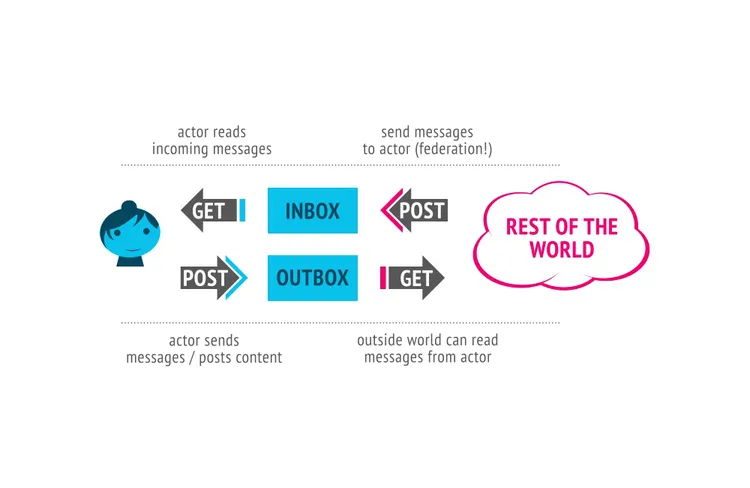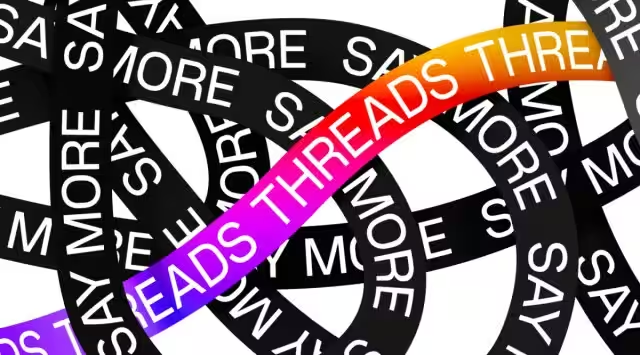What is the Fediverse?
The
Fediverse is basically an inter-network of different social media platforms that use a common protocol to communicate with each other and exchange data. The same way your phone network basically operates. You can be on one phone network and your friend on another. But you still can communicate with that person with ease.
The
Fediverse (a portmanteau of "federated" and "universe") is a collection of protocols, servers, and users. Together, these form networks that can communicate with one another. Users can exchange short messages, blog-style posts, music, and videos over these networks. Content you post is federated, meaning that once one network is aware of your content, it can pass that content to another network, which passes it to another, and so on.Before we dive deeper into the
Fediverse, we need to know a little bit more about the history and how it came to be.A little bit of history for context …
When I first came across the
Fediverse concept it sounded so familiar like the old days when protocols for the Internet was being developed. And lo and behold I found out that the Fediverse actually dates back to the early days of the internet and the development of protocols like email and Usenet, which allowed users to communicate and share information across different servers and networks. In the early 2000s, projects like
Friendica and Diaspora began to explore the idea of creating decentralized social networks.In 2008, Evan Prodromou created a microblogging service called identi.ca using the Ostatus protocol and status.net server software. A few years later, he changed his service to use a new protocol, called pump.io. He released the Ostatus protocol to the Free Software Foundation, where it got incorporated into GNU/social.
Soon thereafter he co-authored what came to be known as
ActivityPub.ActivityPub is an open, decentralized social networking protocol based on Pump.io's ActivityPump protocol. It provides a client/server API for creating, updating, and deleting content, as well as a federated server-to-server API for delivering notifications and content. It has grown to be the most widely supported standard (by some margin) in the
Fediverse.What is the Acitvity Pub Protocol?
ActivityPub is a protocol through which social networks can be made interoperable, connecting everything to a single social graph and content-sharing system. It’s an old standard based on even older ideas about a fundamentally different structure for social networking, one that’s much more like email or old-school web chat than any of the platforms we use now. ActivityPub is not a perfect protocol, and there’s a lot of work left to do to improve it. There’s also a lot that could go wrong and a lot of ways for its potential to be snuffed out by corporate interests or bad technology. And there will be plenty of competition in the race to reinvent social media: social upstarts like Artifact and Substack Notes are building their own closed platforms, and Bluesky, Farcaster, Nostr, and others are building their own open protocols that also aim to decentralize social networking entirely.
So then how does the Fediverse works?
The
Fediverse operating on the ActivityPub offers a more decentralized and democratic alternative to centralized social media networks, allowing users to connect and interact with each other across different platforms. Here's how the decentralized architecture of the Fediverse works:- Federated communication: The servers in the
Fediversecommunicate with each other using open protocols and standards, such as ActivityPub and OStatus.
- Open protocols: The platforms in the
Fediverseuse a set of open protocols and standards, such as ActivityPub, to communicate with each other. These protocols enable users to connect and interact with each other across different platforms, without having to create multiple accounts on different networks.
- User control: Because each platform is independently owned and operated, users have more control over their data and the way it is used. They can choose to use a platform that aligns with their values and needs, and they can easily move their data to a different platform if they choose to do so.
- Interconnectivity: The open protocols used by the platforms in the
Fediverseenable them to interconnect and share data with each other. For example, if a user on aMastodoninstance posts a message, that message can be seen and replied to by users on otherMastodoninstances, as well as users on other platforms that support theActivityPubprotocol.
- Decentralization: The
Fediverseis decentralized, meaning that there is no central authority or company controlling the network. Instead, each platform is owned and operated by independent individuals or organizations, and users have more control over their data and privacy.
- Diversity: The decentralized architecture of the
Fediverseallows for a greater diversity of platforms and communities, each with its own unique features and user base. This diversity fosters innovation and creativity and provides users with a wider range of options to choose from.
But conitinuing from above
ActivityPub is not the only protocol operating in the Fediverse. There are other open protocols that governs how the Fediverse operates like:- Diaspora: Diaspora is a protocol for decentralized social networking that was developed in 2010. It uses a federated architecture similar to that of email, and it allows users to share and communicate with each other across different platforms. Diaspora is used by platforms like Diaspora itself, Friendica, and Hubzilla.
- OStatus: an older protocol that supports basic social networking features like status updates and sharing of media files. It was used by early federated social networks like
Mastodonand GNU Social but has largely been replaced by ActivityPub.
- Zot: Zot is a protocol for decentralized social networking that is used by platforms like Zotadel and Zap.
- Matrix: A protocol originally developed for secure, decentralized instant messaging but now used for a variety of applications, including voice and video chat, file sharing, and collaborative editing. It is used by platforms like Riot and Element.
There are many kinds of
Fediverse servers, often with a specific purpose such as photo sharing, video sharing, livestreaming, book clubs etc. Although the various types of servers work very differently, they talk to each other with a common technical standard called ActivityPub, which means even if you’re not on the same type of server, you can still interact as though you wereOk, this sounds interesting. How do I get on the Fediverse?
The Fediverse, being made of any application using the ActivityPub protocol, is pretty diverse in appearance. As you might imagine, a microblogging platform has different requirements than a video sharing service.
- Mastodon: is a
Fediverseplatform that has gotten a lot of attention lately, and it's focused on microblogging (similar to Twitter or X). calmer, more friendly version of Twitter.
- Meta also has embraced the
Fediversewith their version calledThreadsthat follows the ActivityPub protocol. Weeks-old Threads already dwarfs the Fediverse, which has been around for more than a decade and recently peaked at about 4 million active monthly users. SomeFediversefans see that imbalance as a win: Suddenly, the network could become many times more relevant.
Meta’s vast resources and reach has injected new life into the
Fediverse movement. “This is a clear victory for our cause” wrote Eugen Rochko, CEO of Mastodon, in a blog post on the day Threads launched.
For example, someone on a Mastodon server (which is Twitter-like) can follow an account on a PeerTube server (which is YouTube-like). When the account on a PeerTube server publishes a video, the person following that account from a Mastodon server will see the video appear in their timeline as if it was just a normal a Mastodon post with a video attached.
There are other Popular
Fediverse servers- Pixelfed has an interface focused around displaying images and videos.
- Peertube is for sharing videos.
- Mobilizon is an event planning site, with plans for
Fediverseintegration.
What is Threads 🤔?
If you have been living so far under a rock or unfortunately are in a region where
threads isn't available then this is for you. Threads is an app from Instagram where you can post threads, reply to others and follow profiles that you're interested in. Threads and replies can include short pieces of text, links, photos, videos or any combination of them. People can also follow you to see your threads and replies in their feeds and from your profile.When you create a profile on
Threads, it will be connected to the Instagram account that you logged in with. Meta uses your Instagram account's data in accordance with Meta's Privacy Policy to do things such as - import your profile information,
- personalise your feeds and
- help you stay safe on both apps.
Here is how you can sign up for
Threads:Infact now you can cerify your
Threads profile on Mastodon (If you do not know about Mastodon please read on):Users from other servers will have the name of their server added to their username displayed on Threads (e.g. someone@someserver.com).
The servers in the
fediverse are distributed and decentralised, meaning that changes on one server may not affect other servers. For example, when you delete a post, it will no longer be visible on Threads and Threads will ask other servers to delete it, but the post may still be visible on other servers that Threads doesn't control.Hang On! What is Mastodon 🐘?
By far the most popular type of Fedi server is
Mastodon (or “Masto”) (before the Thread launch) and works a bit like a calmer, more friendly version of Twitter or X or whatever it is called now-a-days.The torrent of former tweeters streaming toward alternative social networks seems to be ongoing, and the social network that gained the most attention at the time is
Mastodon. This open-source network of independent servers (called “instances”) had jumped to 2.5 million users between October and November 2022 — and is continuing its ascent.There are a wide variety of instances available, some aimed at specific groups of people (for example, “data junkies,” “creatives,” or “science fiction fans”), and some more generalized. You can find some places to start with on
Mastodon’s “join” site, or you can do a search for one that follows a specific interest.Here are also a video that explains very plainly what
Mastodon isIf you are the nerdy types and wants more documentation on
Mastodon here you go:This looks great, so is the Fediverse going to be the savior of the world 🤩?
Well yes and no. If you have read this far there are some clear advatages and disadvantages of the
Fediverse Let’s go over the advantages first,
Advantages
- Decentralization: The decentralized architecture of the Fediverse means that there is no single entity that controls it. This means that users control over the data and are less vulnerable to censorship or data breaches. There was a collective effort in 2019 to block the far-right social network Gab after it began using
Mastodon’s software. The effort was considered broadly successful at blocking Gab content from filtering into the Fediverse.
- Privacy: Many Fediverse platforms put emphasis on user data and privacy. Users have more control over their data and can choose which aspects of their profiles are public or private. They can also control who sees their posts and messages.
- Diversity: Because the Fediverse is made up of many different platforms, users have a wider variety of options for social media. This means that users can choose the platform that best suits their needs and preferences. It allows for greater competition and innovation in the development of social media platforms, as developers can create new platforms that fill specific niches or address specific needs.
- Community: The decentralized nature of the Fediverse also means that users can create and join smaller, more specialized communities leading to meaningful interactions and connections.
- Open source: Many Fediverse platforms are open source, which means that the code is freely available for anyone to use, modify, and distribute. This allows for greater innovation and collaboration among developers.
Even though this may sound as the
Utopia people may have been dreaming of there are some issues with it as well. Disadvantages
A little note on the disadvantages. If you read carefully each of the disadvantages you can understand that if established organisations adopt the “ActivityPub” protocol how it can be of benefit to all.
- Complexity: Since many Fediverse platforms are built on open-source software and are designed to be decentralized, they can be more complex than traditional social media platforms. Imagine having to explain to your Grandmom or Grandad on how to use the
Fediverse
- Fragmentation: One of the biggest challenges of the Fediverse is fragmentation. With so many different platforms, it can be difficult for users to connect and communicate with others who use different platforms. This can limit the size and diversity of communities on individual platforms.
- User adoption: Another challenge is user adoption. While the number of users on Fediverse platforms has grown in recent years, it still pales in comparison to the user bases of traditional social media platforms. It can also limit the diversity of perspectives and voices on these platforms. Additionally, the lack of adoption can limit the resources available for platform development and maintenance. Many Fediverse platforms are developed and maintained by small teams of volunteers, which can limit the features and functionality of these platforms.
- Technical complexity: Some Fediverse platforms can be more technically complex than traditional social media platforms. For example, users may need to understand protocols like ActivityPub in order to effectively communicate with other users across platforms. This can create a barrier to entry for some users.
- Limited features: Some Fediverse platforms may have limited features compared to traditional social media platforms. For example, some photo-sharing platforms may not have advanced editing features or the ability to share photos with specific groups of people. This may limit their appeal to some users.
- Learning curve for new users: Another challenge of the Fediverse is the learning curve for new users, especially for those who are not familiar with the technical aspects of the platforms.
- Content moderation will be the thorniest: it’s an expensive, complicated thing to get right, and without good content moderation, social platforms simply don’t work. In many ways, content moderation is the primary product of any social business, and decentralizing that work means only a few large players will be able to afford to do it well.
Here is an interesting paper on content moderation in the
Fediverse that I found interesting- Identity: The widely used
ActivityPubprotocol doesn’t allow for any kind of universal system of identity. When you joinMastodon, you have to pick a server — which is a lot of work and requires a lot of conceptual understanding — and then find people to follow without any kind of cross-server directory. There’s no good tool for verification, either, so if you want to find NPR on the Fediverse, all you can really do is guess which account is the real one.
These are things
ActivityPub will have to learn from protocols like Bluesky, which everyone agrees handles questions of identity and discoverability much better. “We’ve designed a protocol that has three big things we think are missing from the Mastodon ecosystem: account portability, global discoverability, composable, customizable curation and moderation,” — Bluesky CEO Jay Graber recently told The Verge.
What’s next?
I am going to leave you with some resources to get on the
Fediverse that I myself have personally followed and used.- To understand different aspects of
Mastodonand Tips and Tricks → https://fedi.tips/
- An encyclopedia dedicated to all things
Fediverse→ https://joinfediverse.wiki/Main_Page
- Discovering nice servers on
Mastodon→ https://fedi.garden/
- A big list of
MastodonResources → https://researchbuzz.me/2022/11/05/a-big-list-of-mastodon-resources/
My Fediverse Profiles if you are interested to follow:
My Threads Profile:
My IOC Exchange Profile: (a community of InfoSec enthusiasts, professionals sharing not only cybersecurity info with each other)
My Mastodon Social Profile:
References And Credits:
- Photo by Dave Adamson on Unsplash




